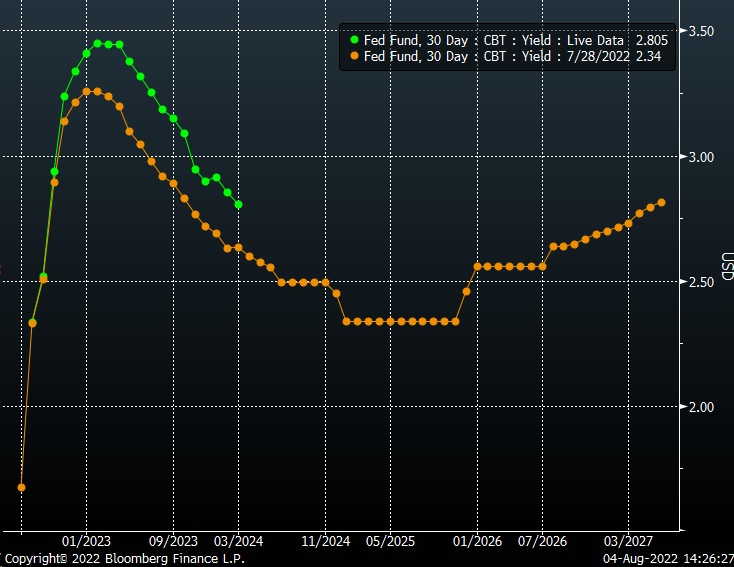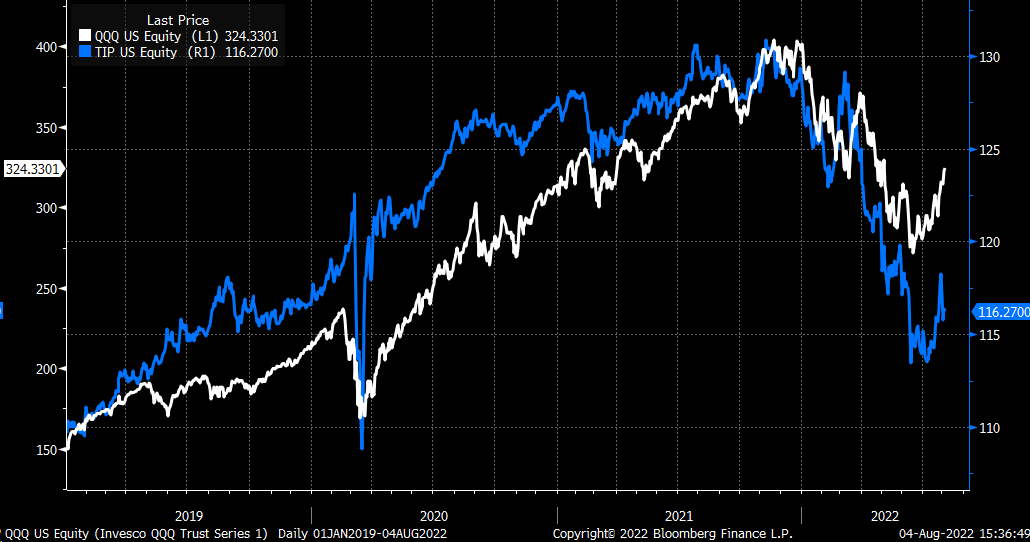- Following FOMC meeting, markets have been pricing a kinder Fed
- But Fed governors and board members have been pushing back
- May turn out that markets have made a massive miscalculation
The pivot to a kinder and gentler Fed may have been a giant mistake by markets. This week there has been a slew of Fed governors and board members who have come out and noted that rates will still need to go much higher and stay there for some time to bring inflation back to their 2% target.
That message appears to be making its way through the markets, with Fed Funds Futures being the first to respond. Just over the past week, the most notable shift appears to have occurred around the timing of the Fed's first rate cut.
Last week, the Fed Fund Futures were pricing in the first rate cut in March 2023, which has shifted to May 2023. Additionally, the Fed Funds Futures saw a peak rate of 3.25%; now, rates are expected to peak at 3.45%. If the Fed has its way, it means rate cuts continue to move further out in time, and expectations for rates move higher.

It may be a subtle shift, but it is a shift because the market had convinced itself following the FOMC meeting that a data-dependent Fed would lead to a more dovish, stock market-friendly Fed. The tone coming from the Fed governors since the meeting suggests the exact opposite: a Fed that may need to raise rates much higher and keep those rates high for longer than expected.
A recent rally in stocks, specifically growth names, has come from easing financial conditions and falling real yields because of the market's distorted view. However, as the market begins to reprice for a Fed that isn't likely to be finished raising rates anytime soon, financial conditions should start to tighten again, and real yields should rise.

Tighter financial conditions would result in margin levels being cut back, while rising real yields would work to reduce the PE ratio and valuations of stocks. The TIP ETF, which, when falling, indicates real yields are rising, has been highly correlated with the QQQ ETF. Over time, the QQQ ETF tends to follow the TIP, and if the TIP begins to move lower again, it seems that ultimately the QQQ should follow the TIP down.
The recent decline in rates and easing financial conditions aren't likely to last as the Fed continues to deliver a more hawkish message. Additionally, the more conditions ease, the more it goes against what the Fed is trying to do, which is to bring down inflation, and to do that, the Fed needs financial conditions to tighten, not ease—making the recent rally seem absurd on many different levels. The rising equity market helps ease financial conditions and ultimately complicates the Fed's job. It may even mean the Fed has to raise rates even more in the long run.
So yes, stocks can continue to rise, but they do so at their peril.
Disclaimer: Charts used with the permission of Bloomberg Finance L.P. This report contains independent commentary to be used for informational and educational purposes only. Michael Kramer is a member and investment adviser representative with Mott Capital Management. Mr. Kramer is not affiliated with this company and does not serve on the board of any related company that issued this stock. All opinions and analyses presented by Michael Kramer in this analysis or market report are solely Michael Kramer's views. Readers should not treat any opinion, viewpoint, or prediction expressed by Michael Kramer as a specific solicitation or recommendation to buy or sell a particular security or follow a particular strategy. Michael Kramer's analyses are based upon information and independent research that he considers reliable, but neither Michael Kramer nor Mott Capital Management guarantees its completeness or accuracy, and it should not be relied upon as such. Michael Kramer is not under any obligation to update or correct any information presented in his analyses. Mr. Kramer's statements, guidance, and opinions are subject to change without notice. Past performance is not indicative of future results. Neither Michael Kramer nor Mott Capital Management guarantees any specific outcome or profit. You should be aware of the real risk of loss in following any strategy or investment commentary presented in this analysis. Strategies or investments discussed may fluctuate in price or value. Investments or strategies mentioned in this analysis may not be suitable for you. This material does not consider your particular investment objectives, financial situation, or needs and is not intended as a recommendation appropriate for you. You must make an independent decision regarding investments or strategies in this analysis. Upon request, the advisor will provide a list of all recommendations made during the past twelve months. Before acting on information in this analysis, you should consider whether it is suitable for your circumstances and strongly consider seeking advice from your own financial or investment adviser to determine the suitability of any investment.
